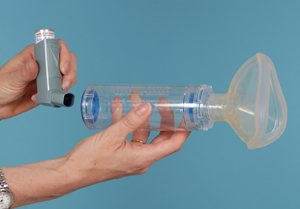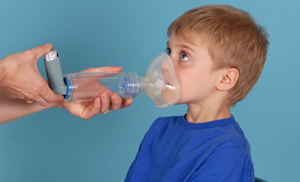Wheezing in children
A wheeze is a whistling sound that is made as a person breathes. It is mainly heard when the person is breathing out. In most cases wheezing is caused by the sound of air trying to move through the breathing tubes of the lungs when they become narrow or tight. The breathing tubes are often called the airways of the lungs.
Causes of wheezing in a young child or baby
Viral chest infections
Wheezing in pre-school children is almost always caused by a viral chest infection. Most children will only wheeze once or twice, while some children will wheeze regularly with viral infections.
Up to two thirds of children who have frequent episodes of wheeze will not be wheezy by age 6 and will not go on to develop asthma.
Viral chest infections cause swelling and mucus to build up in the airways. This makes the airways narrow and causes cough and wheeze. Many viruses can cause wheezing in young children. These viruses are more common in winter.
Asthma
Wheezing in older children is often due to asthma.
Cigarette smoke
Young children who breathe in the cigarette smoke of people around them (passive smoking) have a higher risk of wheezing. Keeping the house and car smoke free at all times is a vital step in helping to avoid wheezing in your child.
How do i find out what is making my child wheeze?
Your doctor will ask you questions about your child and family's medical background. This will help your doctor decide whether it is just a virus causing the wheeze, or whether there is a chance that this might also be asthma.
Tests
Your doctor might test for a virus by taking a little bit of mucus from the back of your child's nose through a long thin tube. The test only takes a few seconds. The mucus is then tested in a laboratory for viruses. These tests are sometimes helpful but do not always help in making a diagnosis.
At the moment, there are no specific tests for asthma. Breathing tests in children over 5 can determine whether obstruction is present which may be asthma. Sometimes a trial of asthma medication may be used to help decide whether your child has asthma.
Treatment of wheezing
For a viral chest infection
Antibiotics do not help treat viral chest infections, so in most cases they are not needed. The virus will go away by itself.
In some children with severe respiratory infections, oxygen may be needed in hospital to help with their breathing. The oxygen is given through a face mask or by a thin tube that sits just inside the nose. The nurses caring for your child will closely check your child’s breathing and their need for oxygen.
Asthma medications may be tried for children older than 12-18 months. For younger children with viral wheezing, asthma medications are less likely to help.
If the doctor suspects asthma

Asthma puffer and spacer
Asthma reliever medication, like Ventolin, will be administered and if the child has asthma, this will help to open up their airways to make breathing easier.
A steroid medication may be given to help your child recover quickly from their asthma. It is usually taken as a syrup or tablet over a 3 to 5 day period. When taken this way it is very safe with no risk of steroid side effects.
Read more about asthma medications and inhaler devices.
Caring for a wheezing child at home
If your child has been given reliever medication, you should have been shown how to use the inhaler device.

It is a good idea to take your child to see your regular doctor within a week of going home from hospital. This is important so your doctor can:Adult helping child with an asthma puffer and spacer
You will also be given an action plan so you know how much of the reliever puffer to give at home, how often to give it and when to stop it. It also details what you need to know in case your child has another wheezing episode.
Follow-up appointment with your doctor
- check to see if your child has improved
- check how much longer your child will need to take the medication
- let you know when to have your child reviewed again.
What should I do if my child ever wheezes or has trouble breathing again in the future?
Follow the instructions written out on your child’s action plan.
Keep the action plan somewhere handy, so you can use it when needed. Take your child to see a doctor as soon as possible.
How will I know if my child is having breathing problems or needs to use their reliever puffer?
It is important to remember how your child looks and behaves when they are well, so that you will notice the difference if they start to have breathing trouble. Watch closely for any signs of a cold or flu, as wheezing or breathing problems may follow.
Any one of the following means that your child is working harder to breathe:
- sucking in between the ribs or at the base of the neck as they breathe in
- breathing harder or faster than normal
- tummy pulling in and out as they breathe
- wheezing
- ongoing coughing.
If your child shows any of the above symptoms follow your child’s action plan, give their reliever and see a doctor as soon as possible.
When should I call an ambulance?
Dial triple zero (000) to call an ambulance for any of the following:
- if your child goes blue at the lips
- if your child can't say more than a few words at a time because they are so breathless
- if your child is so tired they look like they are going to stop breathing
- if your child is breathing very fast, cannot be comforted, is restless
- if your child has trouble feeding because they are so short of breath
- if you or your child is frightened by what is happening.
While waiting for the ambulance, give your child their reliever puffer through their spacer 4 puffs every 4 minutes until the ambulance arrives.
Last reviewed: 07-01-2019
Acknowledgements
Child and Adolescent Health Service – Community Health (CAHS CH)
This publication is provided for education and information purposes only. It is not a substitute for professional medical care. Information about a therapy, service, product or treatment does not imply endorsement and is not intended to replace advice from your healthcare professional. Readers should note that over time currency and completeness of the information may change. All users should seek advice from a qualified healthcare professional for a diagnosis and answers to their medical questions.